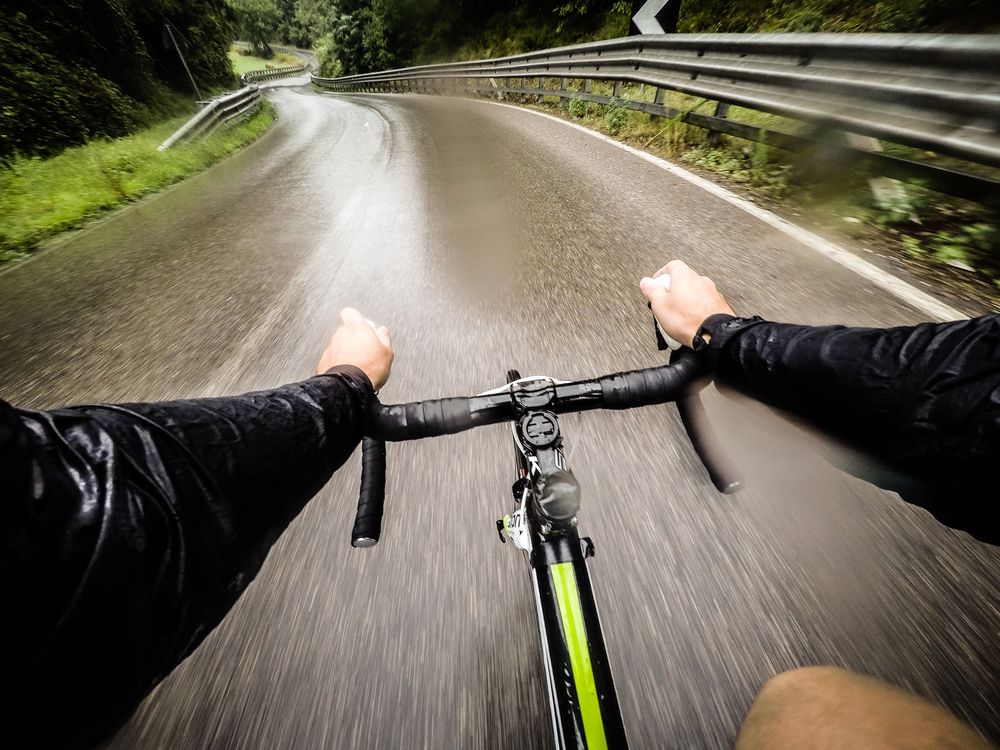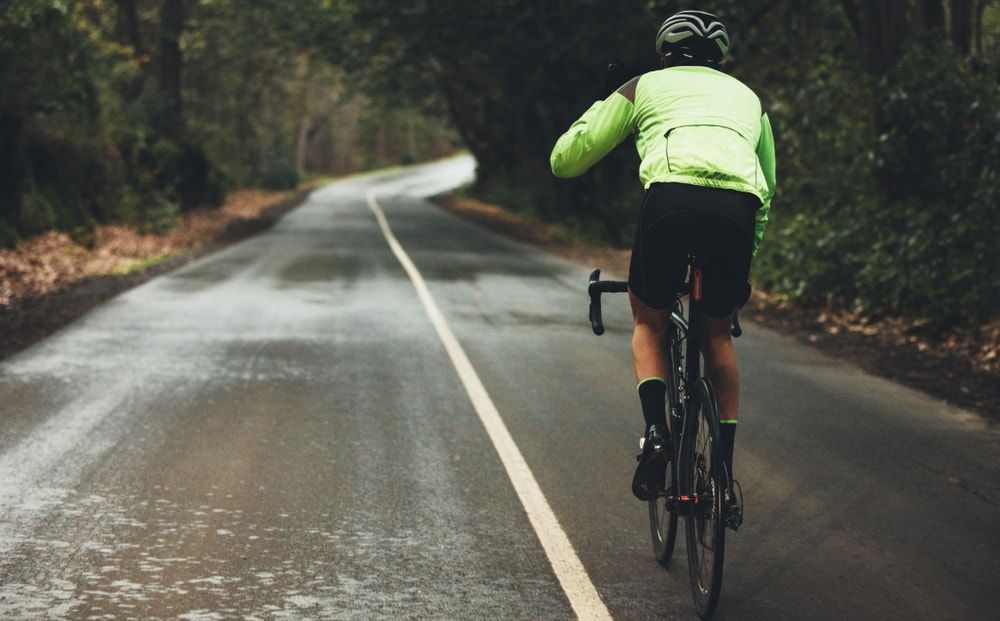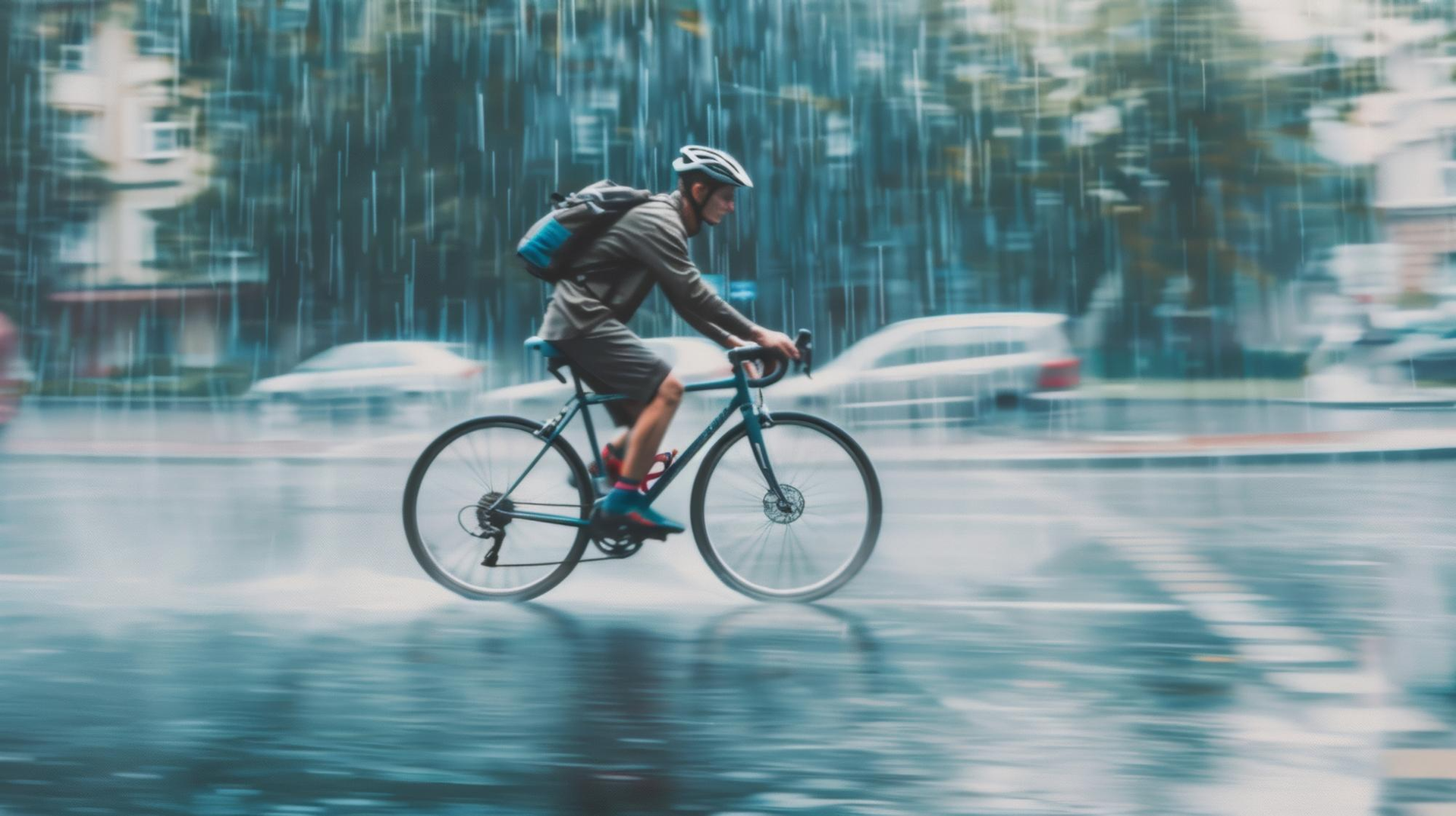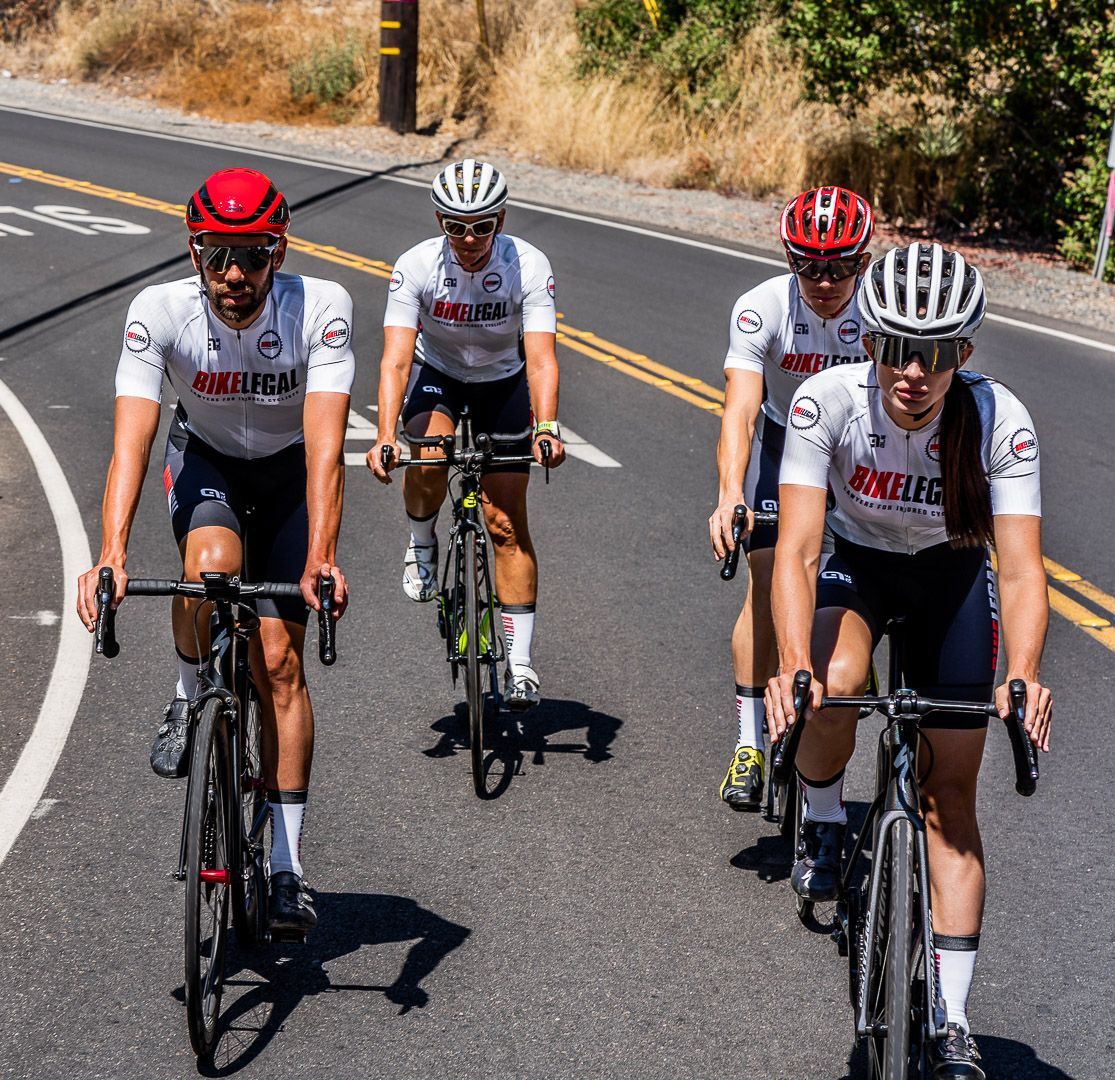Can You Ride a Bike in the Rain? [A Guide]
Follow us on
social media!

According to a study, 58% of cyclists consider the weather when deciding whether to bike. And while some might hesitate at the hint of rain, others eagerly embrace the challenge, equipped with the right gear.
You've landed in the perfect spot if you're curious about cycling in wet weather. In this guide, we'll cover:
- Who Rides in the Rain and Why: Discover the pros and cons of cycling in the rain.
- Safety First: Safety tips for staying safe on slick streets.
- The Big Question: Determine if it's really safe to bike in the rain.
- Gear Guide: Highlight essential items to keep you dry and in control.
Whether it's a drizzle or a downpour, gearing up correctly can transform a rainy ride from daunting to exhilarating.
The Appeal of Riding in the Rain

While rain may be frustrating for some travelers, it also holds a unique appeal for cyclists, transforming routine rides into captivating adventures.
As Mark Cavendish, a professional road racing cyclist, said, “To me, it doesn't matter whether it's raining or the sun is shining or whatever: as long as I'm riding a bike I know I'm the luckiest guy in the world.”
Here's why rainy days are particularly captivating for some riders:
- Challenge and Skill Building: Navigating wet roads requires increased awareness and advanced bike-handling skills.
- For many cyclists, conquering these slippery streets is a clear mark of their skill and resilience, a badge of honor that proclaims, “I can handle anything!”
- Professional cyclists who ride mountain bikes and focus on mastering controlled braking can turn a challenging wet ride into an opportunity for skill development.
- Less Traffic: Rain riding often means fewer cars on the road.
- In fact, light rain can decrease freeway capacity by 4 to 11 percent, and heavy rain can lead to reductions of 10 to 30 percent. This results in a quieter, more relaxed environment, perfect for a leisure ride.
- It's can be an opportunity to absorb the city or landscape with less hustle and bustle, allowing for a more reflective experience on two wheels.
- Enjoying Nature: There’s a unique charm to biking in the rain.
- The fresh scent of rain on asphalt and the sound of droplets on your jacket transform a routine ride into an immersive encounter with nature.
- Wearing waterproof, breathable clothing enhances comfort, turning what could be a soggy ordeal into a welcomed adventure.
- Perceived Toughness: Riding in the rain is often seen as a display of toughness and resilience within the cycling community.
- It’s a cultural badge that cyclists wear with pride, reinforcing their identity as sturdy adventurers.
- Group rides in the rain also strengthen bonds and resilience, elevating the experience beyond a typical dry-weather outing.
Who Rides In Rain and Why?

Rainy days may discourage many cyclists, but for others, they offer a distinct opportunity. Here’s a look at those who thrive on cycling in wet weather and their motivations for riding in the rain:
- Commuters: For those who cycle to work, rain is just another weather condition to manage. These riders find value in maintaining their daily routine regardless of the weather. With the right gear, such as waterproof panniers and rain covers for electronics, commuters can stay dry and efficient on the road.
- Training Athletes: Cyclists training for races or endurance events can't afford to let a little rain disrupt their regimen. These athletes often ride in the rain to prepare for the unpredictability of race day conditions. It’s about building mental toughness and physical endurance in all types of weather.
- Adventure Seekers: Some cyclists crave the thrill of a challenge. Rain adds a layer of complexity and excitement to their rides. By tackling wet and slippery paths, they enhance their biking skills and enjoy the adrenaline rush that comes with mastering difficult terrains.
- Eco-Friendly Advocates: Many choose to ride in the rain out of a commitment to reduce their carbon footprint, rain or shine. These environmentally conscious individuals prefer to stick to bicycles as a sustainable mode of transport, showcasing their dedication to the planet regardless of a little water.
- Social Groups: Some cyclists enjoy the camaraderie of group rides, which often continue regardless of the weather. For example, members of the Cascade Bicycle Club in the Pacific Northwest, where rainy rides are a common occurrence, eagerly tackle wet conditions. Riding in the rain with peers can transform an ordinary outing into a memorable, bonding experience that strengthens group dynamics and builds lasting friendships.
The Risks of Bicycling in Rain

Bicyclists are considered more vulnerable than car drivers due to their exposure to the elements and traffic conditions. Unlike motorists enclosed in their vehicles, cyclists face the open air, making them particularly susceptible to weather and road hazards.
This vulnerability is acknowledged through VRU laws in various states, aimed at protecting bike riders, pedestrians, and other non-motorized road users from incidents.
The rain introduces several risks that cyclists need to navigate:
- Reduced Visibility: Rain can significantly impair visibility for all road users. For cyclists, this means a reduced ability to see road hazards, and for drivers, a decreased capacity to notice cyclists on the road. This mutual reduction in visibility can lead to dangerous interactions between cyclists and motor vehicles.
- Slippery Surfaces: Rain affects both road and trail surfaces, making them slippery and prone to causing slips and falls. Oil residues, wet leaves, and other debris only add to the risk, making it essential for cyclists to be extra cautious. According to data, free-flow speed on freeways can decrease by up to 13% in light rain and up to 17% in heavy rain, indicating that roads become notably more hazardous.
- Braking Difficulties: Wet conditions can seriously affect braking performance, increasing stopping distances. This is critical for cyclists to understand as it impacts their reaction time and ability to stop safely in emergencies.
- Equipment Wear and Tear: Rain and moisture can accelerate the deterioration of bike components. This includes rusting metal parts, wearing out brake pads, and the degradation of tire treads, which can lead to mechanical failures during a ride.
- Hypothermia and Discomfort: Riding in cold rainy weather without appropriate gear can lead to hypothermia. Symptoms like shivering, dizziness, and fatigue can make the ride uncomfortable and can also impair a cyclist’s ability to focus and control their bike.
Amid these risks, being aware of potential dangers can significantly enhance your safety while cycling in rainy conditions.
Essential Gear for Safe and Enjoyable Rainy Day Cycling

When the forecast calls for rain, being properly equipped can mean the difference between a miserable ride and a refreshing adventure. Here's a breakdown of essential gear that can help ensure your cycling experience is safe and enjoyable, even on the wettest days.
Waterproof clothing
- Jackets: Opt for lightweight, breathable, waterproof cycling jackets.
- Gloves: Waterproof gloves can be beneficial for maintaining grip in wet weather.
- Shoe Covers: Keep your feet dry and warm with waterproof shoe covers, which also protect your footwear from mud and road spray.
Protective accessories
- Helmet Covers: Using a rain cover for your helmet is is an option to prevent water from dripping down your face and neck.
- Glasses with Clear or Yellow Lenses: Improve visibility during heavy rain with cycling glasses featuring clear or yellow lenses that enhance contrast during low ligh
Visibility aids
- Reflective Gear: Ensure all reflective materials and advanced bike tech on your clothing and bike are clean and visible to other road users.
- Lights: Front lights and rear lights are mandatory in many regions, especially during overcast or rainy conditions. Opt for high-quality, high lumen lights with multiple settings to enhance your visibility.
Bike modifications and maintenance
- Tires with Enhanced Grip: Switch to tires designed for wet conditions. These have deeper grooves and softer rubber compounds for better traction, crucial if it starts raining unexpectedly. Consider using wider tires for improved stability.
- Fenders: Install full fenders to block road spray from soaking your back and legs, and to protect your bike’s components from excess grime.
- Regular Lubrication and Maintenance: Keep your bike in optimal condition with frequent checks. Use wet lube or chain lube specifically designed for rainy conditions to protect your chain and gears. Pay special attention to brakes, ensuring they are well-adjusted and responsive in wet conditions.
Smart storage solutions
- Waterproof Bags and Panniers: Protect your essentials such as phones, documents, and clothing by using a waterproof bag or panniers. These are especially valuable for commuters who need to carry gadgets and work materials, securing them as the best rain gear for your non-clothing essentials. For extra protection, consider using a plastic bag inside your panniers to double-secure your items from moisture.
For a list of the best rain gear, check out Bicycling Magazine's article: Best Cycling Rain Gear
Pre-Ride Safety Checklist for Biking in the Rain
Before you venture out on a rainy day ride, it's critical to go through a detailed safety checklist to ensure both your safety and a pleasant cycling experience. Here’s a comprehensive checklist to get you road-ready for wet conditions.
Weather assessment
- Weather Update: Always check the latest weather updates before you plan to depart. Stay informed about any alerts for heavy rain or storms that could impact your route.
- Temperature Check: Assess the temperature and wind conditions. This can help you choose the right layers to wear, ensuring you stay warm without overheating.
Bike readiness
- Tire Pressure: Inflate your tires to the optimal pressure for wet conditions—typically lower than usual to increase traction.
- Brakes: Thoroughly test your brakes to confirm they are responsive. The efficiency of brakes can be compromised in wet conditions, making it vital they're in prime condition. Additionally, Applying chain lube can help ensure that the entire braking system operates smoothly.
- Lights: Ensure your front and rear lights are functioning and bright enough for visibility in heavy rain and low visibility.
- Fenders: Check that fenders are securely attached to block road spray and debris, keeping you and your bike clean and dry.
Gear preparation
- Waterproof Clothing: Double-check your rain jacket, rain pants, and shoe covers for any tears or holes to ensure they are fully functional.
- Visibility Gear: Make sure all reflective materials on your clothing and bike are clean and visible to other road users.
- Helmet and Cover: Verify that your helmet fits correctly and that the rain cover is ready for use if needed.
Personal safety items
- Eye Protection: Prepare glasses with clear or yellow lenses to counteract the rain's impact on visibility.
- Gloves: Opt for gloves that offer a reliable grip even when wet, essential for maintaining control of your handlebars.
Navigation and communication
- Route Planning: Strategically plan your route, avoiding paths known for flooding or other hazardous conditions during rain.
- Communication Devices: Confirm that your phone is fully charged and kept in a waterproof saddle bag. Carrying a portable charger is also advisable for longer rides.
Emergency kit
- Basic Repair Tools: Pack a multi-tool, spare tubes, and a portable pump to handle common bike issues.
- First Aid Kit: Include essentials such as bandages, antiseptic wipes, and pain relievers in your first aid kit.
- Identification and Emergency Contacts: Carry identification and a list of emergency contacts, crucial in case of unexpected incidents.
Safety Tips for a Smooth and Secure Rainy Day Ride
Navigating a bike through rainy conditions can be challenging, but with the right tips, it can also be a rewarding experience. Here are some expert tips to help you maintain control and enjoy a smooth ride, even when the weather turns wet.
Enhance your bike handling
Adjusting your speed is critical in wet weather riding. Reducing speed improves your reaction times and ensures that stopping distances increase safely, helping you maintain control over the road surface. Make all movements gradual and smooth to avoid sudden skids, especially on painted lines or railroad tracks.
Optimize your braking technique
To brake safely in the rain without skidding, apply your brakes earlier than in dry conditions to compensate for the braking surface being wet. Use both brakes evenly to distribute the force between the front and rear, which helps maintain balance and control.
Master wet road navigation
When navigating wet roads, avoid riding through puddles or standing water, which can hide potholes or debris and may cause a pinch flat. Also, be cautious of metal surfaces and other slick spots, which become extremely slippery when wet.
Cornering safely
Handling curves and turns on wet roads requires extra caution. Lower your speed before entering a turn and avoid making sharp adjustments to your direction. Lean your body more than your bike to keep a better grip on the road, and always look through the turn to where you want to go, helping you navigate smoothly.
Stay visible and alert
Visibility drops significantly in the rain, so it's important to wear bright, reflective clothing and ensure your lights are working. Heighten your senses and stay alert to quickly react to hazards like slippery manhole covers or sudden changes in traffic.
Adjust your riding position
Lower your center of gravity by bringing your body closer to the frame during rides in wet conditions for increased stability. Maintain a relaxed but firm grip on the handlebars to better handle bumps or slippery spots.
FAQs
How to ride a bike in wet conditions?
- Be Visible: Wear reflective clothing and use bright front and rear lights to make sure you're seen by motorists.
- Stay Dry: Wear waterproof gear to protect yourself from the rain.
- Adjust Your Riding: Brake earlier than usual, avoid slippery surfaces like metal and painted areas, and lower your tire pressure slightly for better traction.
How long can a bike sit in the rain?
A bike can withstand rain exposure for short periods. However, prolonged exposure can lead to rust and damage, especially to components like the chain and gears. It's best to store it dry or cover it if left outside.
Is it safe to ride a bicycle in the rain?
It's safe with precautions. Use lights and wear highly visible, reflective waterproof clothing. Be cautious on slippery surfaces and adjust your speed accordingly to maintain control and prevent accidents.
Key Takeaways
- Preparation is Key: Equip yourself with the right gear such as waterproof clothing, helmet covers, and proper lights to enhance both comfort and safety when cycling in the rain.
- Adjust Riding Techniques: Slow down, use both brakes to maintain control, and avoid sudden movements to handle wet surfaces more safely.
- Stay Visible: Use reflective gear and ensure your lights are functional to improve your visibility to other road users in low-light and rainy conditions.
- Navigate Carefully: Try to avoid puddles and slick surfaces.
- Maintain Your Bike: Regular maintenance, especially using appropriate lubes and checking tire pressure, is crucial to ensure your bike's reliability in wet weather.
Ride Protected, Ride Safe, with BIKE LEGAL

At Bike Legal, we are more than just a personal injury law firm—we are dedicated cyclists representing injured cyclists. If you or someone you know has been involved in a bicycle accident, let us be your advocate.
Cyclists Representing Cyclists
At Bike Legal, our team combines a deep passion for cycling with unparalleled legal expertise. We understand the unique challenges cyclists face and are committed to securing the justice and compensation you deserve. We leverage our personal cycling experience and professional skills to thoroughly analyze every aspect of your accident, ensuring the highest compensation for your injuries and damaged property.
Unmatched Expertise and Proven Results
Specializing in bicycle accident cases, we have handled over 500 claims nationwide, providing exceptional legal advocacy with a thorough understanding of both local and national cycling laws. Our proven track record speaks to our commitment to achieving the best possible outcomes for our clients.
Committed to Cycling Safety
Beyond legal representation, Bike Legal is devoted to educating the public on road safety through our informative blog articles. We believe in fostering a community where cyclists and motorists can share the road responsibly.
Contact Us Today
Request a free consultation by calling 877-BIKE LEGAL (877 245-3534) or submitting a form.

